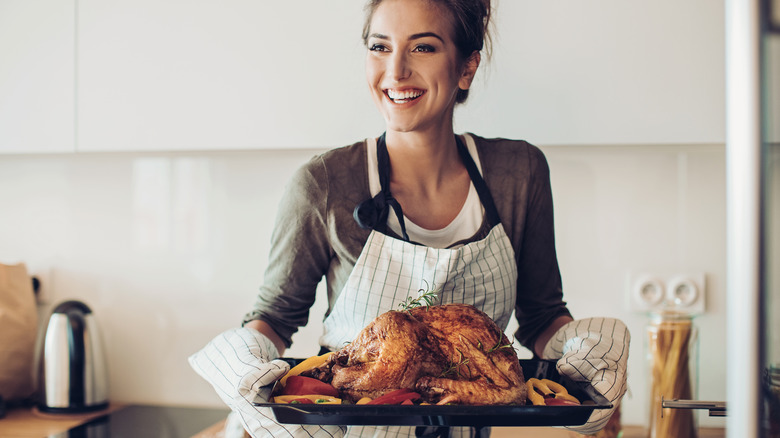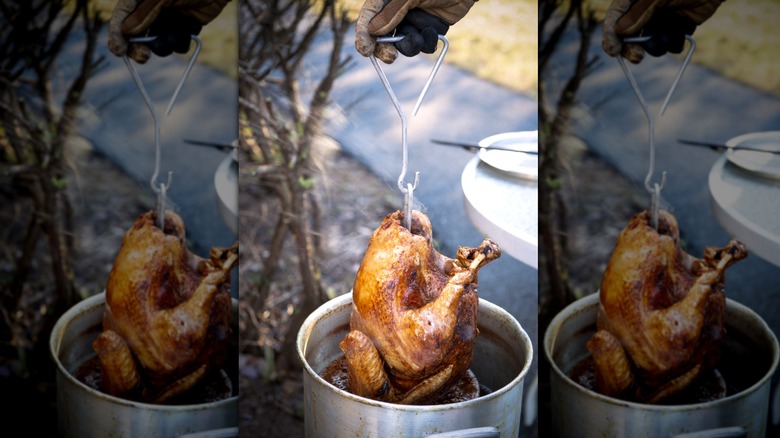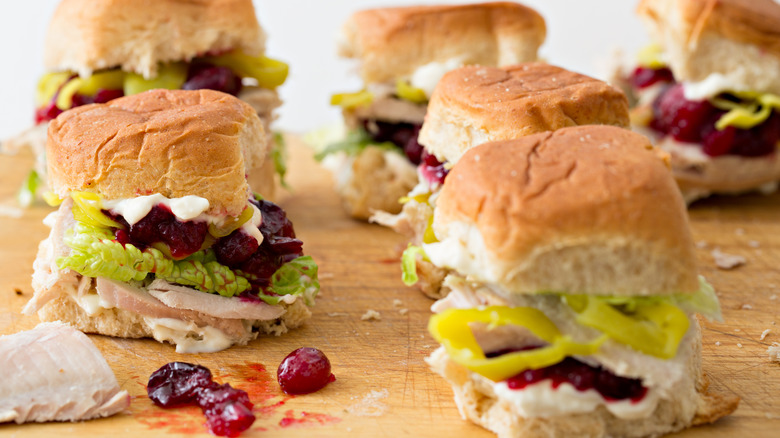14 Clever Ways To Upgrade A Turkey, According To A Butterball Pro
We may receive a commission on purchases made from links.
If you're cooking up the ultimate holiday meal, nothing beats a crispy-skinned roasted turkey with all the fixings. But if you're tired of the same old salt, baste, and repeat, we're dishing the details on how to bring your turkey to life. Not literally, phew.
No excuse is good enough to keep you from the turkey of your dreams. From the collective genius behind Butterball's new Cook From Frozen Whole Turkey, comes Butterball Turkey Talk-Line Supervisor Bill Nolan to address our most pressing concerns — plus, he generously offers the confidence to try something new.
If the Turkey Talk-Line sounds familiar, that's because it's been operating every November through December since 1981. That's over 40 years of turkey problems! Luckily, the people on the other end of the phones know their stuff (and never judge our questions, no matter how many times we ask). From new seasoning techniques, to fun cooking methods, the only equipment you need, and a few surprising time-savers — this year we're all about the tastiest turkey upgrades. It's just like calling 1-800-BUTTERBALL — but with your mind.
Spice up your turkey skin with a seasoned rub
After streaming literal years' worth of cooking shows and culinary docs, you're probably well aware of the need to pre-season your meat. But if you're feeling a little ho-hum about once again applying endless amounts of kosher salt to your turkey's naked flesh, Bill Nolan suggests trying a rub.
"A rub is a combination of dried herbs and spices that can flavor a roasted turkey ... You can make your own, or you can purchase rubs commercially," he explains. There are plenty of turkey rub options on the market, but Nolan offers a few specific flavors to seek out. "Some ingredients that work well together are garlic powder, onion powder, pepper, salt, dried sage, and even paprika or smoked paprika, for a little twist." If you want to add some smokey heat to your turkey, consider a chipotle and paprika rub. "Rubs will mostly flavor the skin or outside of the turkey," Nolan adds, "but you can sprinkle some inside the main cavity to add flavor there as well."
Keep your turkey moist and tender with a wet or dry brine
Maximize your turkey seasoning with vacation-weekend effort by applying a brine that seals in the flavor. "When you use a brine on a turkey, either dry or wet, you are using salt to break down proteins in the meat," Bill Nolan shares. "This allows the meat to hold on to more moisture during the roasting process." While you've got plenty of seasoning options (pickle juice brine, anyone?), no matter spice profile, these two straightforward techniques remain the same. Just don't forget to start with a thawed turkey.
"When you use a wet brine, you submerge the turkey in water that contains the salt and any other flavorings used, which can include sugar and herbs and spices," Nolan explains. "Alternatively, using a dry brine involves salting the turkey thoroughly and letting it rest in the refrigerator." It might seem a smart strategy to let your bird soak-in the seasoning for as long as possible, but Nolan reminds us to stick to your recipe, which can call for brine times anywhere from three hours, to overnight. "Both methods add flavor to your turkey, but be sure not to brine too long. A turkey that is dry-brined for too long can be like jerky, while a turkey wet-brined for too long can be salty."
Nail a tender and juicy turkey with buttermilk
Just a few quarts of buttermilk and some salt make for what might be the simplest way to season a party-ready turkey. But just make sure to plan ahead because this easy recipe can require a brine time anywhere from 12, to 24, to 48 hours before you get to cooking part (and that usually includes a few rotations in the brine so all the parts of the bird get the juice). Even so, Bill Nolan says it's still worth it.
"Using a brine with buttermilk can result in a beautiful golden-brown turkey that is very flavorful," says Nolan. Yes, just like a hero turkey from one of those holiday commercials where there's always a surprise batch of warm dinner rolls after someone nabs the last one. "The meat is tenderized by the acid in the buttermilk, which adds to the overall eating experience. If you're going to use this method, I recommend that you spatchcock your turkey first," (more on that later). This recipe uses a saltwater and lemon wet-brine, which is then followed by a buttermilk, coconut milk, and pomegranate marinade so your turkey has its most moist moment ever.
Don't knock it until you've tried a mayo turkey rub
Okay, just to confirm, nobody's been hitting up the apple cider mimosas and soliciting turkey advice. Mayonnaise is, indeed, a knockout ingredient to easily upgrade your holiday bird.
"We tested this method in the Butterball test kitchens, and we had amazing results," confirms Bill Nolan. Told ya. But he also promises this isn't just another meaningless viral stunt. He explains, "If you want to try this method, simply pat the turkey dry using disposable paper towels. Scoop about 1 to 2 cups of mayonnaise into a small bowl." But don't leave your turkey high and dry without some fun mix-ins. "You can make this your own by adding your choice of dried herbs and spices, including thyme, rosemary, oregano, garlic powder, onion powder, and even lemon zest. Mix it all together and rub all over the outside of the turkey. Then, simply roast as usual." Grab the mayo brand Julia Child loved, or make your own faster than you can say, "Alexa, check off the back-up turkey from my shopping list."
Tempt the senses with a new sauce (but keep the gravy)
If it's a meal that you enjoy just once a year, it can be challenging to venture into uncharted side dish territory (1980s cheesy scalloped potatoes forever). And, for some of us, not having a gravy boat on the table could be punishable by law. But tossing a surprising sauce into the traditional mix just might lead to a new must-have favorite.
Leaning toward the tried and true flavors of turkey's favorite condiment, Bill Nolan admits, "I like the old reliable cranberry sauce, especially if it's homemade." Ina Garten's store-bought cranberry sauce tastes homemade with the addition of a little orange zest and strategic simmering. But Nolan also acknowledges those who like a little kick, something buttery — or even a sweet or smoky dressing for their bird. "Some people like chutneys, barbecue sauce, or even a béarnaise sauce," he says. "But you can't beat a well-made gravy." Live on the edge and make your own béarnaise, or try a new twist on the classics with giblet gravy and basil cranberry sauce.
Skip the turkey juice bath routine
Before you startle awake in the middle of the night, panic-ordering a turkey baster to your front door by 5 a.m., there's something you should know. "Here's a little secret," teases Bill Nolan. "There is no need to baste your turkey." 40,000 grandmas just rolled over in their graves.
"When you baste a turkey, it only flavors the outside, the skin," Nolan explains. But there's another compelling reason to take a break from your basting habit. "Remember that every time you open the oven during roasting your oven temperature drops significantly." And that dramatically slows down the cooking process. Even if you open it for the tiniest little peek, your oven can drop up to 30 F — and then it takes more time to return to the original temperature. "At Butterball we recommend opening the oven when the turkey is about ⅔ of the way done. This is when you can baste if you wish, and also check the temperature of the turkey." Nolan notes that the Butterball method involves "cooking the breast to 170 F and the thighs to 180 F" to ensure that your entire bird is properly done and dusted.
Add an herbed compound butter for a pop of flavor
Most of us are familiar with how a compound butter transforms a mouth-watering steak, but have you tried this trick with your turkey? Follow-up question: What are you waiting for?
Compound butter is just regular butter that's been blended with some type of seasoning. This commonly involves an herb, or a garlic and onion mix, but it can also include miso, dijon mustard, or a garam masala spice blend. (Everything goes with butter.) While some recipes suggest starting the raw turkey off with a butter rub, Bill Nolan warns that this could end up charring the skin of your bird. "I would add the compound butter at the end of cooking," he says. "This is because butter contains milk solids and will burn in the oven. You can try using ghee, which is clarified butter [where] the milk solids have been removed. Even using ghee, I would add it near the end, primarily because if it is added earlier the butter would simply melt away." Polish off your turkey in cowboy butter, some "liquid gold" ghee, or serve a crowd-pleasing thyme, sage, and rosemary butter for guests, on the side.
Slash cooking time in half by spatchcocking your turkey
This term refers to birds that look like they got "spatchcocked" while trying to cross the road to the other side. Turkeys prepared this way (split down the middle and pressed flat) might not show up to dinner with the traditional look, but they make up for it with cooking speed and surface area for seasonings.
"Spatchcocking is one of my favorite ways to make a turkey!" Bill Nolan explains. "This involves a method similar to butterflying. Flip the turkey over, breast side down, and remove the backbone. A good pair of poultry shears come in handy here. Then, flip it back over and press down on the breastbone. You will hear a crack that will allow you to lay the turkey out flat." You're now a certified turkey chiropractor. But this is where the fun begins. "Now, you can roast or grill the turkey, or brine it first using this method to allow more penetration of the brine," Nolan shares. And if you need something more to sweeten the deal, he adds, "Spatchcocking a turkey reduces the cooking time in some cases by half, so be sure not to overcook it." Setting the timer for nailed it-o'clock.
Pat your turkey dry to get the crispiest skin
Sometimes it's the simple things that make the moment; chewy chocolate chip cookies right out of the oven; a comforting bowl of soup; and crispy, golden-brown turkey skin that almost melts in your mouth. Except that last one isn't always as easy as it sounds. Luckily, you can set yourself up for success by giving your turkey a blowout (okay, just patting it dry will also work).
"Make sure that the skin is dry," advises Bill Nolan. "If the skin is wet, it will not brown or crisp up as easily." While some people suggest a hair-dryer method, you can achieve a proper prep by patting the skin dry with regular paper towels. (Just make sure to soak up any moisture hiding in those nooks and crannies.) Then, it's all about getting that bird in the oven. Nolan recommends, "Brush or spray with oil and you are ready to go." Now you can sit back, relax, and enjoy the sunset — oh wait, that's not the sun, it's your golden-brown turkey's irresistible glow.
Practice deep-frying your turkey with water first
To all the thrill-seekers craving that deep-fried flavor, you can test out any-sized turkey scenario by dipping the bird in a vat of water first. "Deep frying a turkey has been popular for years and is a great alternative to traditionally prepared turkey," shares Bill Nolan. Yes, this existed before social media — with envious cooks eyeing their neighbors' deep-fried turkeys in the 1930s. "The cooking itself is fast, about four minutes per pound. However, keep in mind that it's more work, and can be dangerous if you are not prepared," he says. "You'll need a turkey fryer and a good deal of peanut oil."
Never fear, Nolan isn't leaving any of us unattended. He cautions, "Never use a turkey fryer indoors, even in a garage," "Make sure the fryer is on even ground," and definitely, "Do not overfill the fryer with oil!" But how do we guarantee that won't happen? "Practice first with water and the turkey still in its packaging," Nolan explains. "Place the turkey in the pot and fill with enough water to cover by a few inches." Then remove the turkey, leaving just the water in the pot. "Make a mark on the outside of the pot. This is your fill line when you are getting ready to fry." He also advises heating the oil to 375 F, killing the burner when the turkey goes in, and restarting it once your bird's submerged. Safety first. Fried freakin' turkey immediately after.
Add smokey flavor by throwing your turkey on the grill
You can step up your turkey game with all the energy of a summer barbecue by throwing your bird on the grill. This method works for charcoal or gas grills and will have all your neighbors smelling your reason for the season.
"Grilling is a fun and great way to cook a turkey," Bill Nolan confirms. But even though most of us have cooked various meats over the coals, he's got a few tips to keep in mind when it comes to your holiday bird. "Always use the indirect method, whether using a charcoal or gas grill," Nolan shares. "Indirect means that the heat source is on the side(s) and not directly under the turkey. If the coals or gas burners are directly under the turkey it can dry it out quickly." As for the best temperature to use, Nolan adds, "Keep the grill at 325 F or as close to it as you can." And, hey, while you've got the grill going, you can cook up some Brussels sprouts with anchovy sauce, grill your stuffing, or stick the landing with a grilled apple pie.
Stick a meat thermometer in it
You can set the timers, preheat the oven, and fridge-thaw for days, but if you don't check the temperature of your turkey with an actual thermometer, you risk serving a bird that could be raw or overcooked. Either way, no one's asking you to make the turkey again next year.
"Using a meat thermometer is the only way to ensure your turkey will be the best it can be!" explains Bill Nolan. Culinary science and health regulations provide a few good reasons for implementing this technique. "Breast meat on a turkey is very lean with little fat, and if it's overcooked it will dry out quickly. Butterball recommends cooking the breast to 170 F, and the thigh to 180 F," he notes. "Just as important is food safety. Per the FDA poultry must be cooked to a minimum of 165 F to be considered safe. So, having a meat thermometer helps ensure your turkey is safe and is at its optimal doneness for peak flavor." Grab a dial-style thermometer you can leave in your bird (you'll also find options with an app), or you can always treat yourself to Alton Brown's high-end go-to brand. With all this turkey business, you've earned it.
Get your gear on lock for an easier spin in the oven
At the first sign of fall, it feels like open season on marketing for the latest kitchen gadgets and holiday serve ware. Want to zhush up the party with new napkin rings? Go boldly forth. But when it comes to your turkey, stick with the basics.
As Bill Nolan declares, "This is simple!" He adds, "Butterball recommends using the open pan method, which calls for using a pan with a depth of about 3 inches." If you're not ready to commit to a heritage roasting pan, he also says a single-use aluminum foil pan works just as well. "As far as a rack, the open pan method uses a flat rack, not a V-shaped rack," he adds. "If you don't have a flat rack, you can make one using tinfoil. Simply pull out the roll about 3 feet and roll it into a rope. Then, fashion the foil into a circle and rest the turkey on the 'coil of foil.' Using a flat rack helps promote even cooking by letting air circulate all around the turkey." Smell that? That's success.
The only limit on turkey leftovers is your imagination
Life just wouldn't be complete without spending a moment on the holy grail of any roasted turkey dinner: the leftovers. "You can use leftover turkey in soups, tacos, wraps, salads, mac and cheese, and BBQ turkey sliders," notes Bill Nolan. One of everything, please.
For fans dedicated to extending the greatest meal of the year through its last possible moment, try a spicy leftover turkey curry, a cheesy turkey cheesesteak with pickles, or even turkey taquitos packed with beans and potatoes. And who among us could resist a leftover turkey sandwich piled high with everything you ate the day before — plus melted cheese. You can even use your leftover turkey bones to craft a warm bowl of turkey pho. However you slice it, leftover turkey keeps the food party going. The only thing left is to schedule exactly what time we're all getting together the day after Thanksgiving.















